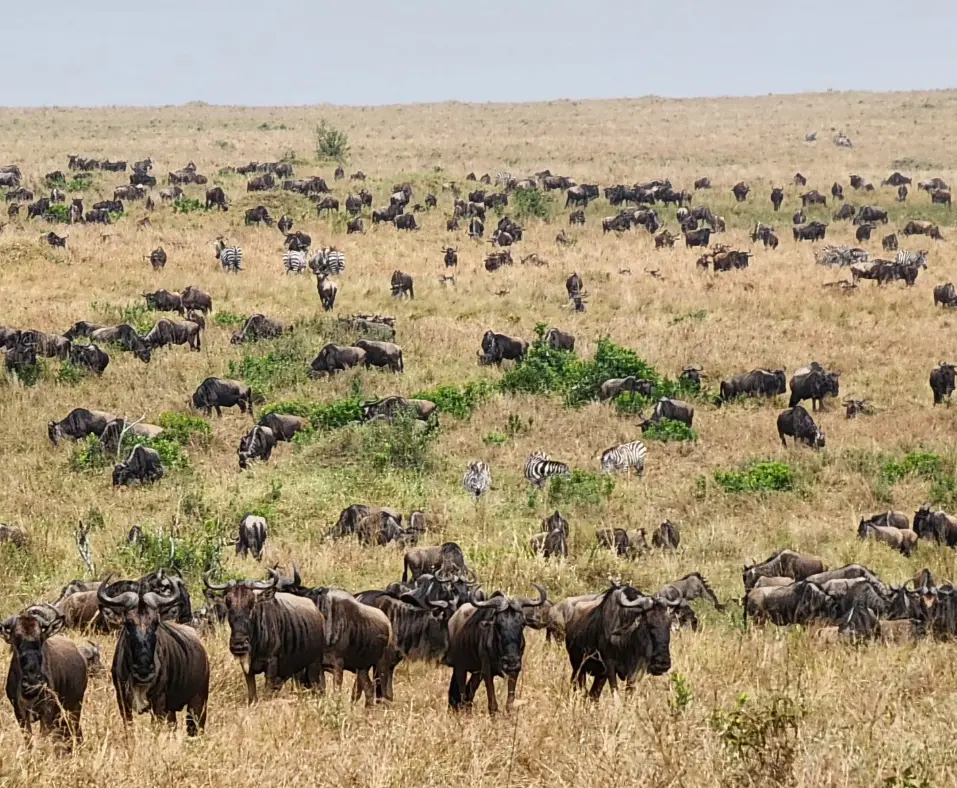
Many travelers ask whether to visit Tanzania's Serengeti or Kenya's Masai Mara for the Great Wildebeest Migration. I assure you today that each offers spectacular viewing and they all have great opportunities to see the Great Migration. The truth is they are part of the same vast ecosystem.
Experiencing both on a Combined Kenya and Tanzania Safari provides the most complete and rewarding adventure.
For a deep dive into the migration's specifics, our guide to witnessing the Great Migration in both Kenya and Tanzania offers valuable insights.
At Kenya Peaks Adventures, we specialize in creating these dual-country journeys, and you can even start designing your ideal trip with our custom trip planner. Choosing East Africa safari packages Kenya Tanzania allows you to witness different, equally amazing facets of this natural wonder.
One Migration in Kenya and Tanzania (Two Countries)
The Great Migration is a continuous, circular movement of over 1.5 million wildebeest, along with zebras and gazelles, across the Serengeti-Mara ecosystem. This vast area, covering approximately 30,000 square kilometers, spans northwestern Tanzania and southwestern Kenya.
The animals are driven by the search for fresh grazing and water, following the rains. National borders mean nothing to these herds; they traverse these lands as one immense, interconnected spectacle.
Therefore, looking at Tanzania and Kenya safari tours provides a comprehensive way to appreciate this phenomenon.
The Serengeti Tanzania Vast Plains and the Calving Season
Tanzania's Serengeti National Park is enormous, offering seemingly endless grass plains dotted with acacia trees and rocky kopjes. It hosts the migration for a significant portion of the year. From around January to March, the southern Serengeti, particularly the Ndutu region, becomes a massive nursery.
This is the calving season, where hundreds of thousands of wildebeest are born within a few weeks. This period attracts many predators, leading to dramatic interactions. The sheer scale of the Serengeti means that even outside peak migration times, wildlife viewing is excellent, and parts of the migration herds can often be found.
The Masai Mara Kenya Concentrated Action and River Crossings
Kenya's Masai Mara National Reserve, while smaller than the Serengeti, offers a very concentrated wildlife experience, especially from July to October. During these months, a large portion of the migration herds crosses from the Serengeti into the Mara in search of fresh grass.
The Mara is famed for its dramatic river crossings, particularly across the Mara River. These events are filled with tension and action as herds face crocodiles and challenging currents. The landscape here features open grasslands, riverine forests, and rolling hills, providing beautiful backdrops for wildlife photography.
Comparing the Experience Landscape Crowds and Accommodation
We now know that both parks are part of the same ecosystem. The thing is, they offer slightly different experiences despite being in the one ecosystem.
The Serengeti's vastness can mean more driving to find specific sightings, but it also offers a sense of immense space and solitude in certain areas. The Masai Mara, being more compact, can sometimes feel busier during peak season, especially around major river crossing points. However, this concentration also means wildlife is often easier to spot.
Accommodation in both reserves ranges from public campsites and budget-friendly lodges to ultra-luxurious tented camps and lodges. The Serengeti has many mobile camps that move with the herds, while the Mara has a high density of lodges and camps, particularly along the rivers.
The Advantage of a Combined Tour Seeing Different Facets of the Migration
Choosing a combined Serengeti and Masai Mara safari allows you to witness the migration from multiple perspectives and at different stages.
You might experience the calving season in the southern Serengeti and then, on the same trip or another, witness the perilous river crossings in the Masai Mara or northern Serengeti.
This approach maximizes your chances of seeing large herds and dramatic events. It also provides a richer understanding of the entire ecosystem and the challenges these animals face.
A combined tour truly offers the best of both worlds for those seeking the ultimate Great Migration experience.
Logistics How to Combine Serengeti and Masai Mara for Migration
Combining the Serengeti and Masai Mara into one safari itinerary is quite feasible. Most travelers fly between the two.
Small aircraft operate regular flights from various airstrips within the Serengeti to airstrips in the Masai Mara, often with a brief stop at a border point for immigration procedures (like Kilimanjaro or a smaller border airstrip).
Road travel between the two is possible but very long and not commonly recommended for tourist itineraries due to the distance and road conditions at the border. Your tour operator, like those we have approved at Kenya Peaks, will handle these logistical arrangements, ensuring a smooth transition.
Choosing Your Timing Aligning Your Trip with Migration Phases
The best time for your combined safari depends on what you want to see.
- December to March: Ideal for the calving season in the Southern Serengeti. The herds are generally not in the Masai Mara at this time.
- July to October: Prime time for river crossings in the Masai Mara and Northern Serengeti.
- June and November: These are transitional months. You might catch herds moving north (June) or south (November), with activity in areas like the Serengeti's Western Corridor or Lobo area.
Discussing your preferences with a safari expert using a tool like our custom trip planner will help align your travel dates perfectly with the migration's movements across both countries. This ensures you make the most of your combined Kenya Tanzania safari experience.